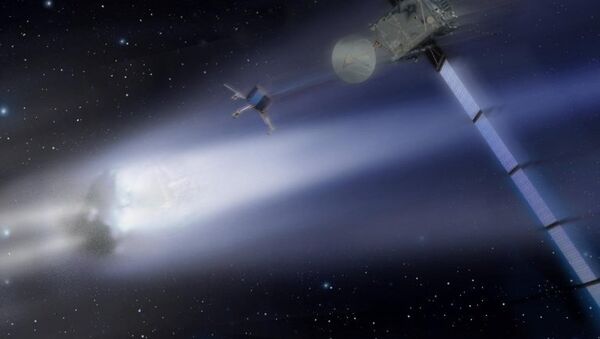MOSCOW. (RIA Novosti commentator Alexander Peslyak) - The spacecraft Rosetta, designed by the European Space Agency (ESA) and launched five years ago, completed a high-orbit "flyby" of Earth on November 13, taking advantage of our planet's gravitational energy to catapult it towards its destination.
In May 2014, Rosetta will rendezvous with the Churyumov-Gerasimenko comet in the vicinity of Jupiter and attempt an unprecedented mission - landing on a comet.
Rene Pischel, the head of the ESA office in Russia, said that for the first time in the history of space exploration, a man-made object will land on a comet, study its surface, take a "soil" sample, and transmit data back to Earth. It is not by chance that the ESA's flagship project in deep space is named after the Rosetta Stone, which first enabled scholars to decipher Ancient Egyptian hieroglyphics. In the same way, modern scientists hope to decipher the origin and evolution of the Solar System, and perhaps even unlock the secret of the origin of life on Earth.
Comet nuclei consist of primordial elements formed billions of years ago in pre-planetary times at the edge of the Solar System. Comet nuclei are of great interest to researchers because these elements have remained unchanged, notes planetary astronomer Alexander Basilevesky.
"Just like a paleontologist reconstructing the image of a prehistoric pangolin, geochemists and astrophysicists will analyze the comet's composition to hypothesize about the source material that for many epochs was pressed, heated, compacted and mixed until it turned into, among other things, the minerals that make up Earth," said Basilvesky.
In other words, by studying the comet and its tail of dust and gas, it is possible to discover the material from which the Earth and other planets were formed.
"We think that the Earth went through a period of intense comet bombardment," said Gerhard Schwehm, the ESA's head of planetary science. "But we don't know what role comets played in forming the atmosphere, and whether they facilitated the formation of large bodies of water."
The Rosetta project is unusual for its sophisticated use of ballistic technologies. The spacecraft took advantage of the gravitational energy of planets - using Mars three times, Earth once - to orbit the Sun for five years. Mikhail Marov, a member of the Vernadsky Institute of Geochemistry and Analytical Chemistry of the Russian Academy of Sciences, said that this gravitational acceleration saves onboard energy and allows the spacecraft to take advantage of the forces of nature.
Pischel said that the calculations of ESA experts, which use data from stations in Australia, Spain and the U.S., turned out to be so accurate that no additional maneuvering has been needed after the trajectory was corrected on October 22.
"The actual flight path differed from the calculations by only a few kilometers," he said.
The three-ton Rosetta spacecraft has two objectives. First of all, it will intercept and accompany the comet in its trajectory towards the sun. Collecting data on the comet will become easier as it approaches the sun, because it will then quickly start to shed the material of its nucleus and its icy body will sublimate into a comet tail. The second objective is to put a landing module on the comet's surface. As the nucleus of the comet is small and its gravitational pull is quite weak, a strong anchor will be needed in order for the mission to be a success.
Rosetta's instruments will be switched off for nearly two years, but the spacecraft will "wake up" as it approaches the comet. Schwehm said that this is necessary because the low-temperature solar batteries (two solar panels with an area of 32 square meters each) are incapable of providing enough energy to power the spacecraft.
"Thankfully, we've already been successful with Giotto, which was shut off for four years on its way to Halley's Comet," he said.
Incidentally, previously launched Soviet interplanetary probes helped the Giotto spacecraft bring its trajectory in line with its destination, noted Basilevsky. And the very first research on comets using a flyby trajectory was conducted in 1986, when the Soviet unmanned spacecraft Vega 1 and Vega 2 took around 1,500 photos of Halley's Comet and its nucleus, and also collected large amounts of data, including on the ice's rate of sublimation (40 tons per second).
Basilevsky added that as soon as the European project was announced, the Americans rushed to design and launch several light spacecraft of their own for comet exploration. In general, Basilevsky considers this method of rapidly copying what has already been done counterproductive.
"And so everybody rushes to repeat the same thing with variations," he said. "It's not a breakthrough, it only confirms that they can also do such a thing. We don't need to spread ourselves thin. We have the Phobos-Grunt project, two lunar missions and a lunar rover mission. We are adept at landing on planetary surfaces and bringing back rock samples. And we are also good at joining major international projects."
The opinions expressed in this article are the author's and do not necessarily represent those of RIA Novosti.



